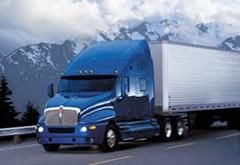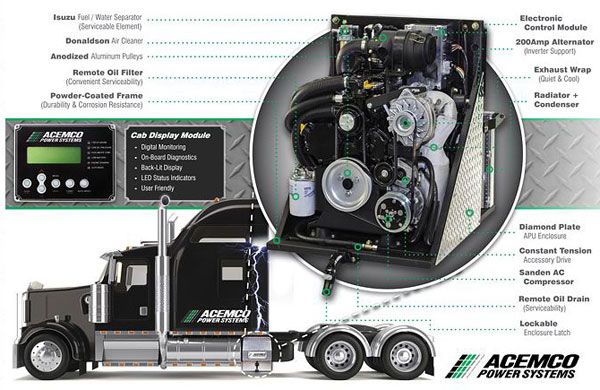Bad Shippers?
Topic 18576 | Page 4
realizing your mistake with the air
I meant brakes.
realizing your mistake with the air
I meant brakes.
Combination of both actually.
When running an air suspension trailer - if you pop the trailer air, it dumps the suspension. When you dump the suspension, it pulls UP on the front of the trailer (depending on how much weight is loaded towards the rear), pulling UP on the kingpin, and causing it to PULL UP on the drives.
This shifts weight OFF the drives and ONTO THE STEERS.
Had a conversation with G-Town - because the entire scenario seemed weird, the way the weights were moving around in a weird fashion - especially with weight added to the steers in that fashion. We kicked this around a bit - and came to these conclusions.
I was looking at the "pure physics" of the equation - and just couldn't fathom why the weights shifted the way they did.
Figure the axle sets like pivot points on a see-saw. Then throw in what happens when you dump the airbags on the trailer and change the height of the pivot point (which is what happens when you set the trailer spring brakes by killing the supply air - which also supplies air to the suspension).
This makes an interesting lesson for EVERYONE (including me), especially on how to get accurate weights on a scale. Set the trailer brakes with the trolley/johnson bar. If you have to shut the motor off if you have to talk to the cashier, there's plenty of air left to keep the brakes applied while you weigh (remember the leakdown test). You should only set one set of brakes - in order to keep from "loading up" tension between the "braked" axle sets.
This was a cool issue to figure out. Didn't conform with the "average weights & balances" problem.
Still would have run with 100lbs over on the steers and burnt the fuel off. Would have loved to see what the "actual weights" were with the brakes set correctly.
Rick

You were not overweight. And, unfortunately, you didn't need to waste any time getting your load re-worked. The 12,000 lbs. limit you have been told is, in fact, a "nominal" amount. It varies from state-to-state and whether or not it is the Interstate or a state route. The 12,000 lbs. figure comes from the fact that the Interstate system allows a maximum (un-permitted) gross weight of 80,000 lbs. and most states allow a maximum for tandems of 34,000 lbs. Subtract two sets of tandems at 34,000 lbs. each from 80,000 lbs. and this leaves 12,000 lbs. remaining.
However, EVERY state allows a maximum (un-permitted) weight of 20,000 lbs on a steer axle on the Interstate. Many states allow as much as 22,400 lbs. and Mass. allows 24,000 lbs. (This is also where the 40,000 lbs. figure for split-tandems comes from as they are treated as two single axles)
The maximum any vehicle is allowed is the lesser of: 1. The manufacturer's maximum for the axle as noted on the door-jamb tag 2. The manufacturer's maximum for the tires as noted on the sidewall at maximum cold inflation 3. The maximum allowed by legislation by either total weight or weight per inch of tire width.
As noted, your tires allow 6,500 lbs. each, which is 13,000 lbs. I am willing to bet your axle probably allows 12,500 lbs. So, you were, in all likelihood, perfectly fine. Not even the 100 lbs. over you thought you were the first go-round.
What about state routes, you ask? Ohio allows 650 lb/in (tire width) Indiana - 12,000 lbs. Illinois - 20,000 lbs. Wisconsin - 13,000 lbs., Class B Highways - 12,000 lbs.
Even if your axle is only rated at 12,000 lbs., I wouldn't even think twice about rolling with 100 lbs. over. No one will give you so much as a second glance. More than 300 lbs. over? Yeah, be careful. Over 80,000 lbs. gross? Not a good idea. Again, though, if it was 80,100 lbs. I wouldn't hesitate to go. Especially, as has been mentioned, if you've got a ways to go before you cross a scale and you'll burn off enough fuel before you cross one. Know what diesel weighs (nominally just slightly more than 7 lbs. per gallon, so using 7 is good) and what your burn rate is.
BTW, all the weight and road information is in the front of the Rand McNally Motor Carriers' Road Atlas. Lots of other useful information in there too. Get one... it will save you some time and headaches in the future.
Tandems:
Tandem Axles
A set of axles spaced close together, legally defined as more than 40 and less than 96 inches apart by the USDOT. Drivers tend to refer to the tandem axles on their trailer as just "tandems". You might hear a driver say, "I'm 400 pounds overweight on my tandems", referring to his trailer tandems, not his tractor tandems. Tractor tandems are generally just referred to as "drives" which is short for "drive axles".
Tandem:
Tandem Axles
A set of axles spaced close together, legally defined as more than 40 and less than 96 inches apart by the USDOT. Drivers tend to refer to the tandem axles on their trailer as just "tandems". You might hear a driver say, "I'm 400 pounds overweight on my tandems", referring to his trailer tandems, not his tractor tandems. Tractor tandems are generally just referred to as "drives" which is short for "drive axles".
Interstate:
Commercial trade, business, movement of goods or money, or transportation from one state to another, regulated by the Federal Department Of Transportation (DOT).
DAC:
Drive-A-Check Report
A truck drivers DAC report will contain detailed information about their job history of the last 10 years as a CDL driver (as required by the DOT).
It may also contain your criminal history, drug test results, DOT infractions and accident history. The program is strictly voluntary from a company standpoint, but most of the medium-to-large carriers will participate.
Most trucking companies use DAC reports as part of their hiring and background check process. It is extremely important that drivers verify that the information contained in it is correct, and have it fixed if it's not.
TWIC:
Transportation Worker Identification Credential
Truck drivers who regularly pick up from or deliver to the shipping ports will often be required to carry a TWIC card.
Your TWIC is a tamper-resistant biometric card which acts as both your identification in secure areas, as well as an indicator of you having passed the necessary security clearance. TWIC cards are valid for five years. The issuance of TWIC cards is overseen by the Transportation Security Administration and the Department of Homeland Security.

Dumb question; do you have an APU? If so, you should have a sheet in your permit book showing the weight of the apu and you're typically allowed that.
Nah I have no apu. Wish I did.
OWI:
Operating While Intoxicated
APU:
Auxiliary Power Unit
On tractor trailers, and APU is a small diesel engine that powers a heat and air conditioning unit while charging the truck's main batteries at the same time. This allows the driver to remain comfortable in the cab and have access to electric power without running the main truck engine.
Having an APU helps save money in fuel costs and saves wear and tear on the main engine, though they tend to be expensive to install and maintain. Therefore only a very small percentage of the trucks on the road today come equipped with an APU.


Well I got my new weights at a truck stop WITHOUT dumping the brakes. I kept both brakes released:
10300 31800 32440 74540
I moved my tandoms 2 holes to the rear also.
Here are my previous weights:
12460 28660 33600 74720
Also I was able to bypass an indiana weigh station (they were open). I got the green on my transponder to keep rolling.
Well I got my new weights at a truck stop WITHOUT dumping the brakes. I kept both brakes released:
10300 31800 32440 74540
I moved my tandoms 2 holes to the rear also.
Here are my previous weights:
12460 28660 33600 74720
Also I was able to bypass an indiana weigh station (they were open). I got the green on my transponder to keep rolling.
Thanks for the update Aaron. You have provided an excellent education for Veteran and Rookie drivers alike!


Aaron, I want to thank you for having the courage to put your "lack of experience" problem here for discussion. This has been a fascinating thread as a result, and I'm sure many future readers will gain valuable knowledge because of it.
My only experience with weigh stations so far has been "rolling" weighs. As a flatbed trainee, we only had a couple loads that were close on weight, and in each case my trainer just relied on the shippers weight.
This is really good info that I'll certainly use in the future. Thanks again.
Shipper:
The customer who is shipping the freight. This is where the driver will pick up a load and then deliver it to the receiver or consignee.
Turtle, Once you are on your own, you may want to scale "Heavy" loads. Gladhand got a weight violation ticket in Illinois several months back. $1200!!! That took a bite out of his paycheck for several weeks as he had to pay swift back thru payroll deductions. Some shippers will try to fudge their weights a bit. An extra 20-30 minutes to hit a CAT scale can save you headaches. After you get pulled into the inspection lane for an Overweight load or axle, the Inspector may have a bit of extra time on his hands to go over your Rig with a fine toothed comb! Just my $.02.

Shipper:
The customer who is shipping the freight. This is where the driver will pick up a load and then deliver it to the receiver or consignee.
CAT Scale:
A network of over 1,500 certified truck scales across the U.S. and Canada found primarily at truck stops. CAT scales are by far the most trustworthy scales out there.
In fact, CAT Scale offers an unconditional Guarantee:
“If you get an overweight fine from the state after our scale showed your legal, we will immediately check our scale. If our scale is wrong, we will reimburse you for the fine. If our scale is correct, a representative of CAT Scale Company will appear in court with the driver as a witness”
DAC:
Drive-A-Check Report
A truck drivers DAC report will contain detailed information about their job history of the last 10 years as a CDL driver (as required by the DOT).
It may also contain your criminal history, drug test results, DOT infractions and accident history. The program is strictly voluntary from a company standpoint, but most of the medium-to-large carriers will participate.
Most trucking companies use DAC reports as part of their hiring and background check process. It is extremely important that drivers verify that the information contained in it is correct, and have it fixed if it's not.
Turtle, Once you are on your own, you may want to scale "Heavy" loads. Gladhand got a weight violation ticket in Illinois several months back. $1200!!! That took a bite out of his paycheck for several weeks as he had to pay swift back thru payroll deductions. Some shippers will try to fudge their weights a bit. An extra 20-30 minutes to hit a CAT scale can save you headaches. After you get pulled into the inspection lane for an Overweight load or axle, the Inspector may have a bit of extra time on his hands to go over your Rig with a fine toothed comb! Just my $.02.
I absolutely hear ya Tman. I do plan to scale every time I'm heavy, and Prime encourages it. As a company driver, it won't cost me anything but a little time. My trainer was a l/o, and a cheap one at that. A few bucks for a scale is money well spent, in my opinion.
Shipper:
The customer who is shipping the freight. This is where the driver will pick up a load and then deliver it to the receiver or consignee.
CAT Scale:
A network of over 1,500 certified truck scales across the U.S. and Canada found primarily at truck stops. CAT scales are by far the most trustworthy scales out there.
In fact, CAT Scale offers an unconditional Guarantee:
“If you get an overweight fine from the state after our scale showed your legal, we will immediately check our scale. If our scale is wrong, we will reimburse you for the fine. If our scale is correct, a representative of CAT Scale Company will appear in court with the driver as a witness”
DAC:
Drive-A-Check Report
A truck drivers DAC report will contain detailed information about their job history of the last 10 years as a CDL driver (as required by the DOT).
It may also contain your criminal history, drug test results, DOT infractions and accident history. The program is strictly voluntary from a company standpoint, but most of the medium-to-large carriers will participate.
Most trucking companies use DAC reports as part of their hiring and background check process. It is extremely important that drivers verify that the information contained in it is correct, and have it fixed if it's not.
New Reply:
New! Check out our help videos for a better understanding of our forum features

















Preview:
This topic has the following tags:
Driver Responsibilities Trailers Truck Equipment Weight and Scales







 TT On Facebook
TT On Facebook
Aaron, realizing your mistake with the air brakes made it worth my while and hopefully others as well to read through 3 pages of replies to get to the root of the problem. I'm very glad you posted this and worked through it... you may have just saved many a rookie from making the same mistake. Thanks for 'taking one for the team.'